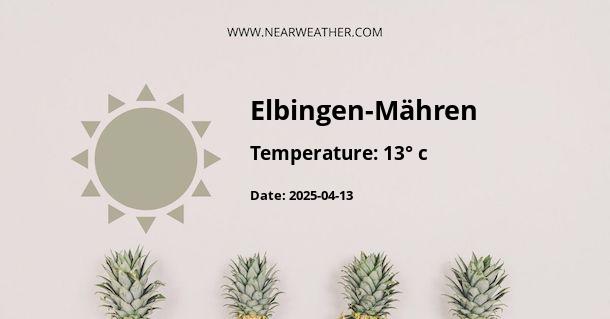Understanding the Climate and Weather in Elbingen-Mähren, Germany
The quaint village of Elbingen-Mähren, located in Rhineland-Palatinate, Germany, exhibits a temperate oceanic climate, with mild to warm summers and generally cold winters. This climatic condition is a result of its geographical position within Central Europe and its proximity to large bodies of water and topographical variations. Below, we delve into the intricate details of Elbingen-Mähren's climate, outlining the seasonal variations, temperature fluctuations, and precipitation patterns.
Temperature Overview
The annual temperature in Elbingen-Mähren varies quite moderately throughout the year. Residents and visitors alike experience four distinct seasons, each with its own characteristic weather patterns.
- Summer (June to August): The summer in Elbingen-Mähren is typically mild with average high temperatures reaching around 24°C (75°F). However, heat waves can occasionally drive temperatures above 30°C (86°F).
- Autumn (September to November): Autumn brings cooler weather as the average temperatures begin to decline. By November, daily highs hover around 6°C (43°F), with lows around 1°C (34°F).
- Winter (December to February): Winters are generally cold with average low temperatures in January, the coldest month, falling to -3°C (27°F). Snowfall is common, and the area is occasionally subjected to below-freezing temperatures throughout the season.
- Spring (March to May): Spring witnesses a gradual warming with an average high temperature in May reaching about 18°C (64°F). This season is particularly appreciated for its renewal of flora and fauna after the winter's dormancy.
Precipitation Patterns
Elbingen-Mähren receives a steady distribution of rainfall year-round. Precipitation charts indicate no dry season, and there are no extreme variations in the monthly rainfall.
"In Elbingen-Mähren, one can expect an average of 700 mm (27.56 inches) of precipitation annually, spread relatively evenly with a slight increase during the summer months due to thunderstorms." — Local Climatological Data
Monthly Climate Statistics
For a more detailed understanding, let's examine the average monthly temperatures and precipitation in Elbingen-Mähren:
| Month | Avg High (°C) | Avg Low (°C) | Precipitation (mm) |
|---|---|---|---|
| January | 3 | -3 | 50 |
| February | 4 | -2 | 43 |
| March | 9 | 0 | 55 |
| April | 14 | 3 | 49 |
| May | 18 | 7 | 72 |
| June | 22 | 11 | 70 |
| July | 24 | 12 | 79 |
| August | 24 | 12 | 65 |
| September | 19 | 9 | 60 |
| October | 14 | 5 | 59 |
| November | 7 | 2 | 66 |
| December | 3 | -1 | 67 |
Wind, Sunlight, and Other Climatic Factors
The area's geography also plays a significant role in influencing other climatic factors such as wind patterns and sunlight hours:
- Elbingen-Mähren experiences moderate wind speeds throughout the year, which are typically higher during the winter months when fronts are more frequent.
- The region receives different amounts of sunlight during the year, with longer days in summer and shorter days in winter, affecting the number of daylight hours.
- Topography including elevation changes and the presence of the nearby Westerwald mountain range can impact local microclimates, sometimes creating unique weather conditions within the Elbingen-Mähren area.
Extreme Weather Events and Climate Change
Like many parts of the world, Elbingen-Mähren is not immune to the effects of climate change:
"Recent trends have shown an uptick in extreme weather events, including more intense heat waves in the summer and erratic precipitation patterns. This emphasizes the importance of ongoing climate research and monitoring in this region of Germany." — Global Climate Change Monitoring Agency
Extreme weather events such as floods, storms, and extended dry periods can have substantial impacts on agriculture, infrastructure, and the natural environment. The locals are increasingly aware of these shifts and are taking steps to adapt to and mitigate the impacts of climate change on their community.
Best Time to Visit
For those looking to visit Elbingen-Mähren, the best time to do so would depend on personal preferences and planned activities:
- For warm weather activities: Visit between June and August.
- For winter sports: Plan a trip between December and February.
- For experiencing the village's scenic beauty: Spring (March to May) and Autumn (September to November) are ideal for enjoying the changing landscapes.
Conclusion
Elbingen-Mähren's climate is characterized by its temperate weather, influenced by its central European locale and topographical diversity. Understanding this village's annual weather patterns, including temperature dynamics and precipitation distribution, is essential for residents and visitors preparing to engage with the local environment throughout the year. It's clear that, alongside these natural patterns, changes in the global climate have started to leave their mark on Elbingen-Mähren, leading to a greater focus on sustainability and environmental conservation within the community.
A - Elbingen-Mähren's Latitude is 50.533329 & Longitude is 7.916670.
A - Weather in Elbingen-Mähren is 13° today.
A - Climate Conditions in Elbingen-Mähren shows overcast clouds today.
A - Humidity in Elbingen-Mähren is 74% today.
A - Wind speed in Elbingen-Mähren is 12.31 km/h, flowing at 225° wind direction. today.
